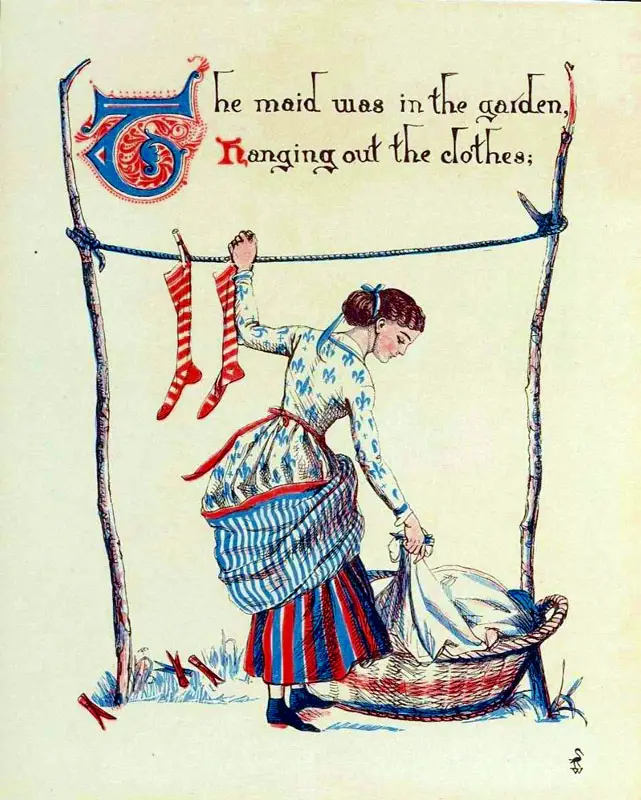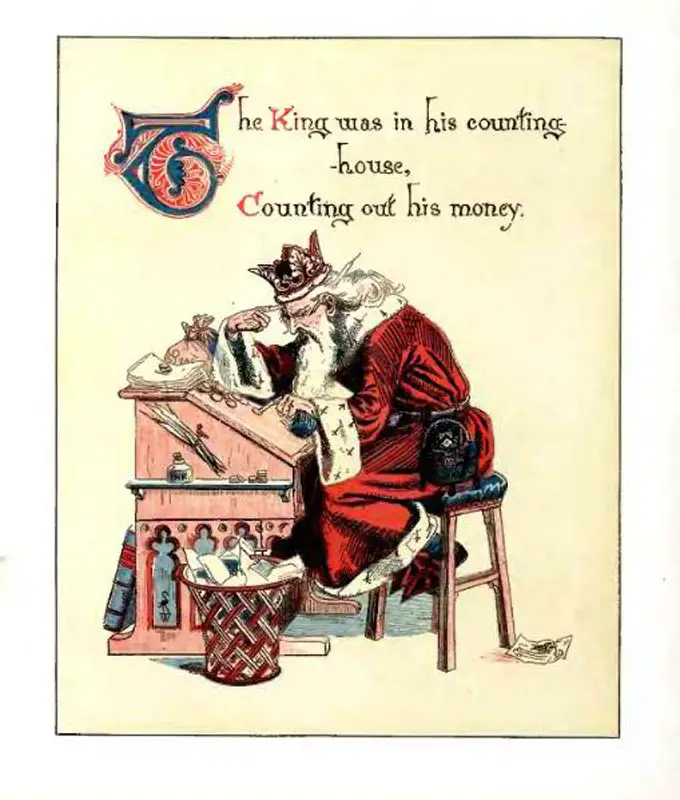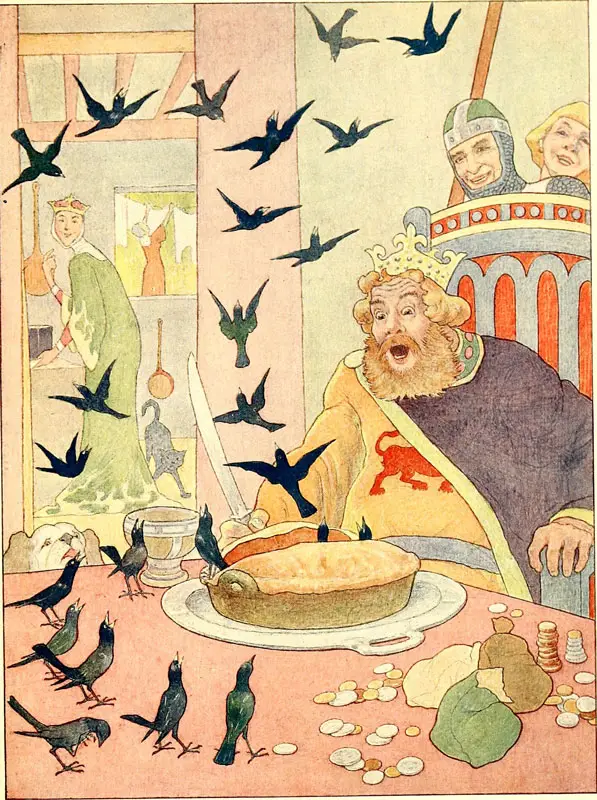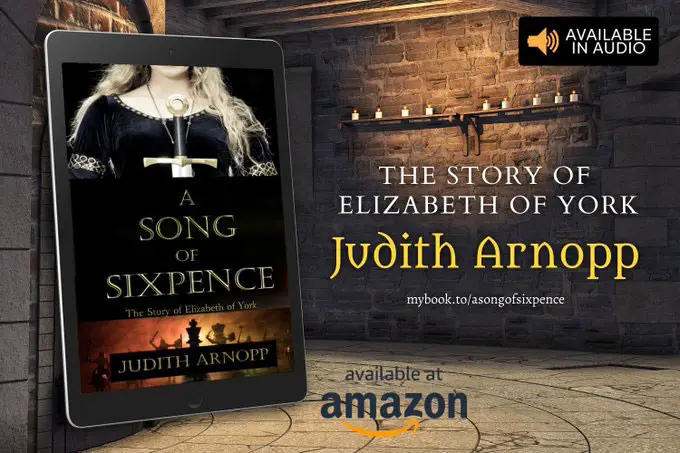December 11: Sing a Song of Sixpence
Thank you to Judith Arnopp for this interesting look into a nursery rhyme that many people know and love. Did you know about the origins of this rhyme?
Sing a song of sixpence a pocket full of rye,
Four and twenty blackbirds baked in a pie.
When the pie was opened the birds began to sing,
Oh, wasn't that a dainty dish to set before the king?
The king was in his counting house counting out his money,
The queen was in the parlour eating bread and honey
The maid was in the garden hanging out the clothes,
When down came a blackbird and pecked off her nose.

There are many theories as to the origins of the nursery rhyme Sing a Song of Sixpence. Some see it as an early lampoon of the extravagances of royalty, some as a satire of Henry VIII and Katherine of Aragon with Anne Boleyn playing the part of the maid. The blackbirds baked in the pie represent the disaffected monks after the dissolution of the monasteries.
One account I stumbled across equated it with the pirate Blackbeard as ‘a coded message that evolved over several years' times and was used by confederates of the notorious pirate Blackbeard to recruit crew members for his prize-hunting expeditions.’
I was more than a little surprised to learn this and a little further exploration revealed that the claim was indeed a hoax, almost as perplexing as the Blackbeard link. You can read more of this link with Blackbeard here (i) and here(ii)
As an author of historical fiction, I prefer the links to the Tudors. Although Sing a Song of Sixpence was first published in the 18th century it certainly has origins in the 16th. Perhaps sixpence was the going rate for a good song during this time. There are references to singing for sixpence during a drunken conversation between Sir Toby Belch and Sir Andrew in Shakespeare’s Twelfth Night.
SIR ANDREW: Excellent! Why, this is the best fooling, when all is done. Now, a song.
SIR TOBY BELCH: Come on; there is sixpence for you: let's have a song. (Twelfth Night, Act II Sc. III)

Of course, no Tudor banquet was complete without minstrels, and it is easy to imagine the king and queen seated before a groaning table, dining on exotic dainties to the strains of music from the gallery.
During the Tudor period (and certainly before that) extravagant dishes were created to amaze and enthral the king. Swans and peacocks were roasted and the feathers then replaced to make it appear the birds were still living. Dishes such as dolphin and porpoise were not unheard of and with recipes like these, it must have been an unenviable task for the chefs to dream up new and innovative dishes to tease the royal palate.
Songbirds were regularly eaten; it is only one step further to serve the dish a little al dente so why hesitate at a pie full of live birds? It wouldn’t have been so unusual. An Italian cookbook from 1549 contains a recipe ‘to make pies so that birds may be alive in them and flie out when it is cut’(iii). And a description of the wedding of Henry IV of France and Marie de Medici says,
‘The first surprise, though, came shortly before the starter – when the guests sat down, unfolded their napkins and saw songbirds fly out.(iv)’
One version of the rhyme was published in Tom Thumb’s Pretty Song Book in around 1744. Instead of four and twenty black birds it has four and twenty ‘naughty boys’ beneath the crust. What else, one wonders, would you do with twenty-four disobedient children?
Sing a Song of Sixpence,
A bag full of Rye,
Four and twenty Naughty Boys,
Baked in a Pye.

At school, I was taught that the king and queen in the rhyme were Henry VII and Elizabeth of York. (Incidentally, Elizabeth also graces the playing card and the likeness between the card and contemporary portraits are obvious.)
Henry Tudor is often depicted as being ‘careful’ with money and so fits quite comfortably in the counting-house. Whether this idea of Henry’s miserliness originated with the poem or vice versa it is not possible to say. His taxes were unpopular but that is not at all unusual, people never like to pay taxes. But, miserly or not, his careful control of finances meant that at his death the royal coffers were full; he would likely have turned in his grave if he’d known how quickly and thoroughly his son, Henry VIII, emptied them, squandering his father’s riches on war and theatricalities.
Like most consorts, Elizabeth of York took no part in governing the country; her role was purely a domestic one, concerned with the children and charitable works, so the depiction of her eating bread and honey in the parlour fits quite nicely.
In my novel, A Song of Sixpence, Elizabeth is not depicted scoffing bread and honey in the parlour, instead she battles to come to terms with the loss of the primary male members of her family and saving her surviving kin from a similar fate.
Her marriage to Henry VII is initially problematic and not helped by the appearance of a man claiming to be her brother Richard of York, thought to have perished in the Tower in 1483.
Like many female historical figures, Elizabeth is usually presented in fiction as a daughter, wife or mother; almost as two dimensional as the image on the playing card. But she was a real woman, with real emotions, who lived in very turbulent times. I thought it important to give her a voice, put some flesh on her bones, some thoughts in her head and give her the credit she is due.
And the same for Henry. He is usually painted as either a cold calculating king or a complete monster. In A Song of Sixpence, he is portrayed as many shades of grey (no, don’t worry, it isn’t that sort of book). Initially, he is by no means an easy man to live with; his years of exile have left him insecure, with a chip on his shoulder that threatens both his marriage and his rule. His reign suffered more uprisings than any other and he can scarcely have enjoyed a quiet moment, but Elizabeth was raised in England and as the daughter of Edward IV and Elizabeth Woodville has learned how to be a dutiful wife and an influential queen. Between them, they negotiate the transition from medieval to early modern England and although they were from enjoying a fairy tale ending, they do at least have their own nursery rhyme – or I think so, anyway.

References
- http://www.snopes.com/lost/sixpence.asp
- https://www.snopes.com/fact-check/mostly-true-stories/
- (Giovanni de Roselli's Epulario, quale tratta del modo de cucinare ogni carne, ucelli, pesci... (1549), of which an English translation, Epulario, or the Italian Banquet, was published in 1598 (Mary Augusta Scott, Elizabethan Translations from the Italian no. 256, p. 333f.)
- Blow out! History's 10 greatest banquets - Features, Food & Drink - The Independent